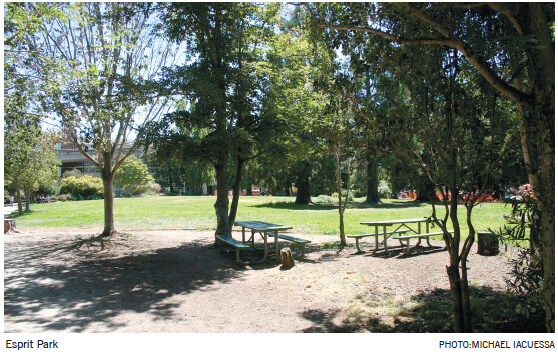Recent improvements to paths at Esprit Park are just the beginning of possible changes to Dogatch’s oldest and largest green space. As part of the Dogpatch Public Realm Plan, launched in 2015, the San Francisco Planning Department has been soliciting comments for a possible re-design of the park, which borders 19th and 20th streets at Minnesota. The department has held three public meetings to discuss potential upgrades; more workshops are slated for the fall.
Thus far the effort has elicited issues that’re long familiar to Esprit Park users: whether to add a designated off-leash dog area, a children’s playground and a north side sidewalk. There’s also been discussion about extending the park to the 20th Street overpass.
The Planning Department has created three blueprints, but project manager Robin Abad Ocubillo cautioned that those are preliminary, and are mainly being used for discussion purposes. The designs include a picnic area, plaza and community garden. “One thing that seems universal is that people love the forested natural feeling, and that’s what’s really special about Esprit Park,” Ocubillo said. “What we want to maintain is that feeling of a natural wooded space.”
The area around the park has changed considerably over the past decade. An increase in dogs in recent years has been prompted by two new housing developments adjacent to the space. University of California, San Francisco student housing is slated just to the north. A nearby preschool has expressed a desire to use the park more.
Ocubillo described the creation of the Realm Plan as “a way of looking at all the assets of Dogpatch and trying to understand Esprit Park as one part of a larger system of parks. Informal parks, street parks, sidewalk plantings; all these sites fall under different jurisdictions and City agencies. The plan is the way we can coordinate them.”
As part of the effort, City planners want to identify potential improvements to Tunnel Top Park, at Pennsylvania and 25h streets, and Warm Water Cove, at the end of 24th Street. Community advocates want to find ways to buffer Tunnel Top from vehicle traffic; at Warm Water Cove suggested changes include a skateboard park, kayak landing, and creating a more “natural” landscape. Comments are being solicited now; redesign decisions won’t be made until next year.
The east-west path upgrade at Esprit was spearheaded by the Dogpatch and Northwest Potrero Green Benefit District (DNWP-GBD), which was established last year, and is funded by a fee on local properties. “The path had fallen into disrepair,” explained Julie Christensen, who was named DNWP-GBD’s first executive director in June. “It was water-logged and needed irrigation. To restore the path we made some minor alterations to help manage the water better.” DNWP-GBD is also evaluating the health of park trees.
According to Christensen, DNWP-GBD is the first “green benefit district” of its kind in the country. Benefit districts are typically established as a means to improve business areas; San Francisco’s other 14 benefit districts are located along commercial corridors. In those areas, property owners are levied a tax to fund improvements in the district. DNWP-GBD is the first one to focus on open space and greening. “The benefits districts exist to bridge the gap between the power and resources of the City and the highly focused awareness of the community,” Christensen explained.
Included in DNWP-GBD’s scope are sidewalk plantings, graffiti cleanup and parklet maintenance. As an example of the latter, Christensen sited a small park on Indiana at 24 and 25th streets that was created by neighbors. The organization wants to restore a footbridge over Highway 101 at the end of Utah Street, and is also tasked with seeking ways to expand open space in the neighborhood.
With its open meadow surrounded by trees offering a hint of forestry, Esprit Park was created in 1980 by environmentalists and Esprit Corp. co-founders Douglas and Susie Tompkins as a corporate garden for their adjacent business headquarters. The park still draws workers at lunchtime, dog owners after work hours, and a cross section of neighbors on weekends.
“We are doing what we can to keep the park vibrant and healthy,” said Christensen. “There are a lot of expectations imposed on this green space because it is so rare in the area.”


